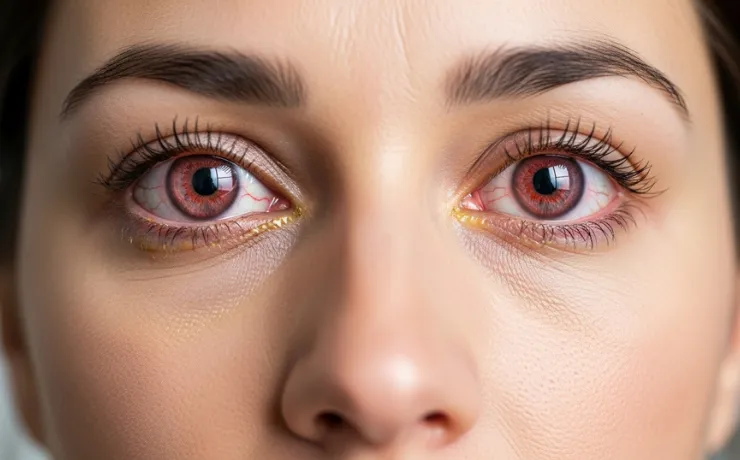Pink Eye Symptoms and Treatments Available at Your Pharmacy

Pink eye, or conjunctivitis, is a common eye condition that causes redness, irritation, and discomfort. While it can affect people of all ages, it is especially common in children and individuals in close-contact environments such as schools or workplaces.
At Farmington Drugs, we help patients understand the different types of pink eye, recommend safe over-the-counter (OTC) treatments, and provide guidance on symptom management and prevention.
What Is Pink Eye?
Pink eye is the inflammation of the conjunctiva, the thin, clear tissue that covers the white part of the eye and the inside of the eyelids. The condition can be caused by several factors:
-
Viral infections: Often associated with colds or respiratory infections; highly contagious.
-
Bacterial infections: May produce thick discharge and require medical evaluation.
-
Allergic reactions: Triggered by pollen, dust, pet dander, or other allergens; usually not contagious.
-
Irritants: Such as chlorine in swimming pools, smoke, or contact lens solutions.
Common Symptoms of Pink Eye
Symptoms vary depending on the cause but often include:
-
Redness in one or both eyes
-
Itching or burning sensation
-
Watery or thick discharge from the eye
-
Crusting on eyelashes, especially after sleep
-
Swelling of the eyelids
-
Sensitivity to light
Note: Viral and bacterial infections can spread easily, so early recognition and management are important.
Over-the-Counter Treatments
OTC options can help relieve symptoms, particularly for mild viral or allergic conjunctivitis:
1. Lubricating Eye Drops (Artificial Tears)
-
How they work: Moisturize and soothe irritated eyes.
-
Best for: Redness, dryness, or mild irritation.
-
Tips: Use several times a day as needed to reduce discomfort.
2. Antihistamine Eye Drops
-
How they work: Reduce itching and redness caused by allergic reactions.
-
Best for: Allergic conjunctivitis triggered by pollen, dust, or pets.
-
Tips: Follow dosing instructions carefully; avoid overuse.
3. Cold Compresses
-
How they work: Reduce swelling, itching, and discomfort.
-
Best for: Both viral and allergic pink eye.
-
Tips: Apply for 5–10 minutes several times a day.
4. Saline Rinse
-
How it works: Gently flushes out irritants and allergens.
-
Best for: Mild irritation due to environmental triggers.
-
Tips: Use sterile saline solutions and avoid tap water.
Important: Bacterial pink eye may require prescription antibiotic drops, so consult a healthcare provider if symptoms are severe, persistent, or worsening.
Home Care and Prevention
Alongside OTC treatments, certain strategies can help manage symptoms and prevent spread:
-
Practice good hand hygiene: Wash hands frequently, especially before touching your eyes.
-
Avoid sharing personal items: Towels, pillowcases, and makeup can transmit infection.
-
Clean contact lenses properly: Disinfect lenses and avoid wearing them until symptoms resolve.
-
Avoid touching or rubbing eyes: This reduces irritation and the risk of spreading infection.
-
Stay home if contagious: Children and adults with viral or bacterial pink eye should limit contact with others.
When to See a Healthcare Provider
Consult a healthcare provider if you experience:
-
Severe pain or sudden vision changes
-
Thick, yellow or green discharge
-
Symptoms that persist beyond a week or worsen
-
Swelling that affects the eyelids or surrounding area
-
Recurrent episodes or a history of chronic eye conditions
Prompt evaluation ensures proper diagnosis and treatment, especially when bacterial infection or other eye conditions are involved.
The Role of Your Pharmacist
Pharmacists are a valuable resource for managing pink eye:
-
Recommend safe OTC treatments based on symptoms
-
Advise on proper use of eye drops and compresses
-
Identify signs that require medical evaluation
-
Provide guidance on hygiene and preventive measures
-
Educate on allergy management for recurrent cases
At Farmington Drugs, our pharmacists can help you manage mild symptoms, reduce discomfort, and ensure you receive timely care if more serious treatment is necessary.
Safety Tips for OTC Use
-
Follow dosing instructions carefully for eye drops and ointments
-
Do not share medications with others
-
Use sterile products to prevent further infection
-
Remove contact lenses if recommended, and avoid wearing until symptoms improve
-
Consult a pharmacist if you are pregnant, nursing, or taking other medications
Final Thoughts
Pink eye is a common but manageable condition with proper care. Recognizing symptoms early, using OTC relief safely, and following good hygiene practices can reduce discomfort and prevent the spread of infection.
At Farmington Drugs, our pharmacists are here to guide you in selecting the safest and most effective treatments, provide advice on home care, and determine when professional evaluation is needed. With the right approach, pink eye can be managed effectively and safely, restoring comfort and eye health.





